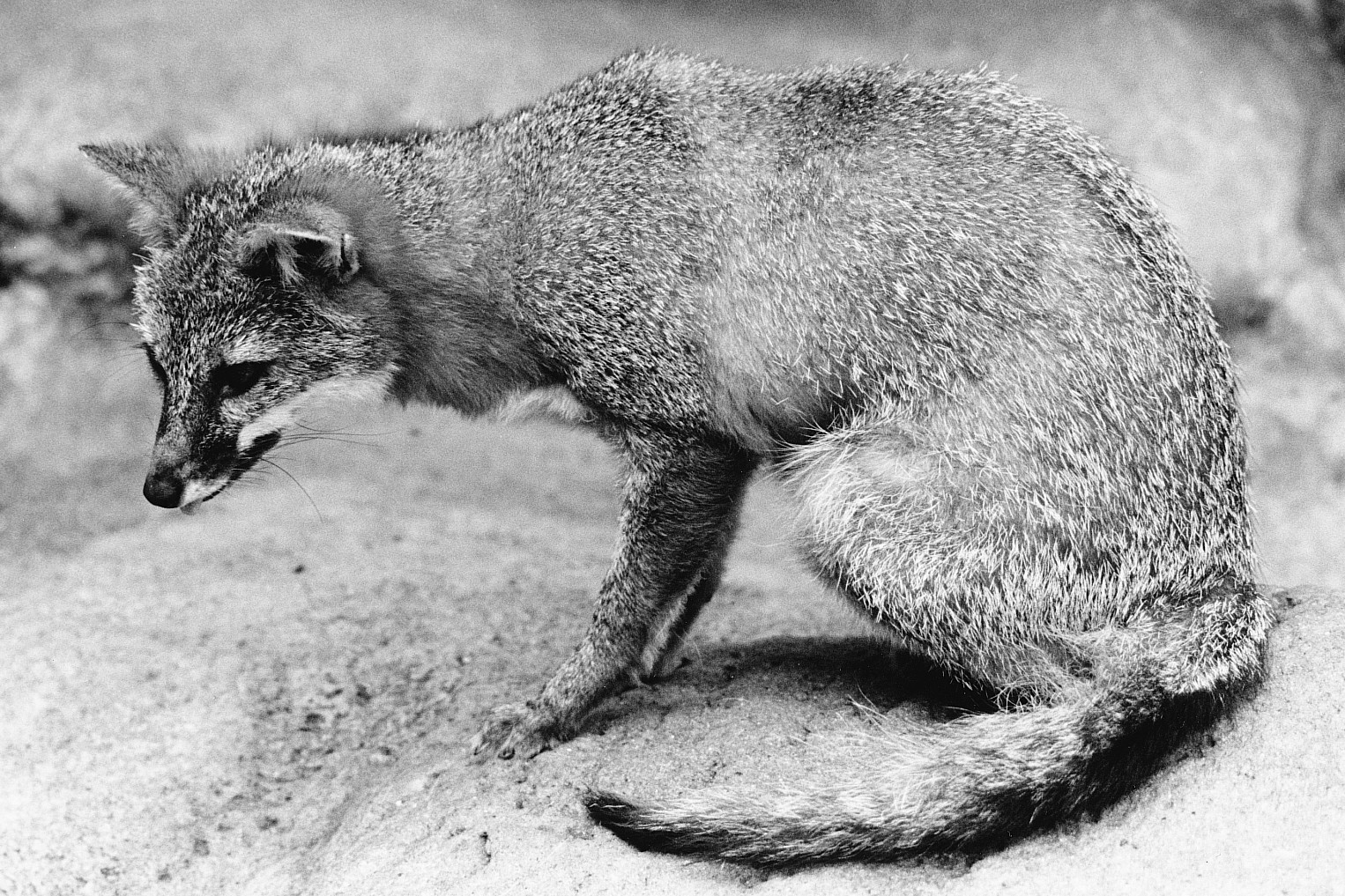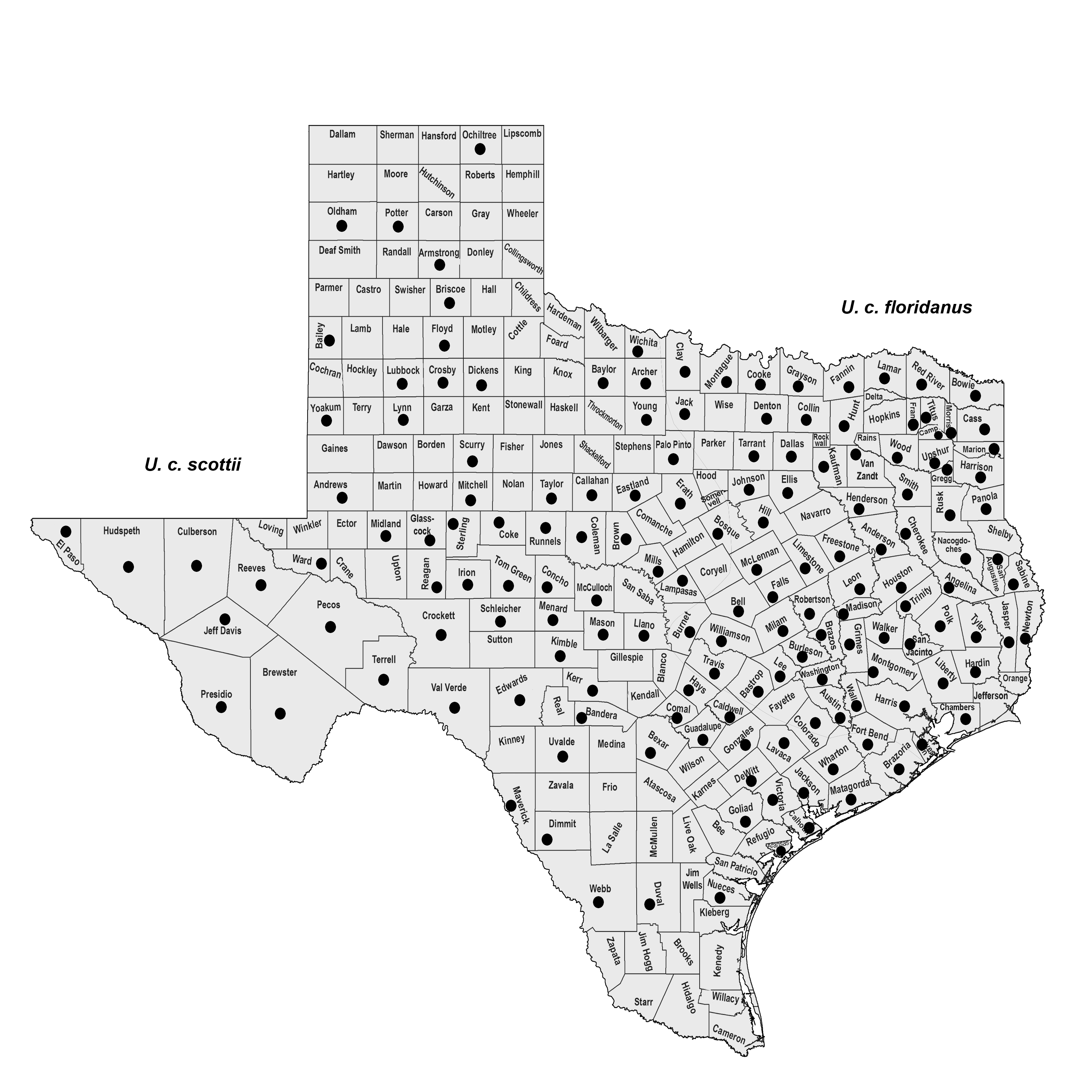COMMON GRAY FOX
Urocyon cinereoargenteus (Schreber 1775)
Order Carnivora : Family Canidae
DESCRIPTION. A medium-sized fox with grayish upperparts, reddish brown legs, tawny sides, and whitish throat, cheeks, and midline of belly; sides of muzzle and lower jaw with distinct blackish patch; tail with distinct blackish stripe on upperside and black tip (no white on end of tail as in the red fox); tail roughly triangular, not round, in cross section; skull with distinct lyrate-shaped (U-shaped) temporal ridges, which meet only at hind part of skull. Dental formula: I 3/3, C 1/1, Pm 4/4, M 2/3 × 2 = 42. External measurements: total length, 970 mm; tail, 347 mm; hind foot, 143 mm. Weight, ordinarily 3–5 kg, occasionally as much as 9 kg.

DISTRIBUTION. Statewide.

SUBSPECIES. Urocyon c. floridanus east of the Balcones Fault zone and U. c. scottii in the western two-thirds of the state.
HABITS. Gray foxes are especially common in the Post Oak Savannah, Cross Timbers and Prairies, and Edwards Plateau regions, where they occupy both upland and bottomland communities. They apparently benefit from habitat edges created by humans, including the borders of woodlands that result from the common practice of clearing small, irregular areas for croplands or pastures. They also inhabit urban areas, being almost equally at home in cities as their native habitats.
Common gray foxes are social animals, with the primary unit being the family consisting of an adult male and female plus a number of juveniles. These foxes are thought to be monogamous, with the pair bond remaining intact throughout the year. The breeding season probably extends over several months from December to early March, with peaks from late January to early February. There is only one litter per year, and the range in litter size is about two to six, averaging four. The gestation period is about 53 days.
Gray foxes are most active at night, although they occasionally move about during the early morning and late afternoon. When traveling from one location to another, they frequently follow old roads or open trails and forage in thickets of dense underbrush.
These foxes use a variety of places for denning sites, such as scrap or brush piles, space under old houses, holes in rocky outcroppings, cavities in hollow trees, and occasionally underground burrows dug by other animals or the foxes themselves. Dens in hollow trees may be as high as 9 m above ground. Den sites are commonly located in dense cover and not very far from water.
Common gray foxes are adept climbers, which is unusual for canids. They climb trees to escape predators, to feed on birds, or to rest and sun. They use their rounded claws to ascend the tree trunk in a fashion like that of bears, and they are capable of leaping from branch to branch like a cat. The photographer Wyman Meinzer has photographed gray foxes feeding in the tops of century plants.
Their diet varies seasonally, but the most important items (in order of decreasing importance) are small mammals, birds, plants, and insects. They eat a variety of small mammals, including white-footed deermice, woodrats, cotton rats, pocket mice, harvest mice, and cottontail rabbits, with the last being the most important item in their diet. They also eat a variety of passerine birds, but they seem particularly fond of robins, towhees, and mourning doves as well. Persimmons are their most important plant food, although they also eat yaupon and deciduous holly berries, acorns, and grasses.
Gray foxes are thought to live 6–10 years in the wild. Major factors causing mortality include predation, parasites, diseases, and humans. Large hawks occasionally take pups, and adults may be eaten by golden eagles, coyotes, and bobcats. Rabies and mange also appear to serve as a control mechanism in fox populations when density is high.
The gray fox is among the four most important fur-bearing animals in Texas. The most important ecological regions for harvesting gray foxes are the Cross Timbers and Prairies and the Edwards Plateau.
POPULATION STATUS. Common. The common gray fox is widely distributed throughout most of the state. It remains common throughout its range, although more so in the eastern part than elsewhere.
CONSERVATION STATUS. The IUCN lists the common gray fox as a species of least concern and one that is increasing its range in some areas. Gray foxes do not appear on the federal or state lists of concerned species. Potential threats to this species could include overharvesting by trappers and predator control practices.
From The Mammals of Texas, Seventh Edition by David J. Schmidly and Robert D. Bradley, copyright © 1994, 2004, 2016. Courtesy of the University of Texas Press.
Natural Science Research Laboratory
-
Address
Museum of Texas Tech University, 3301 4th street, Lubbock, TX 79409 -
Phone
806.742.2486 -
Email
nsrl.museum@ttu.edu

